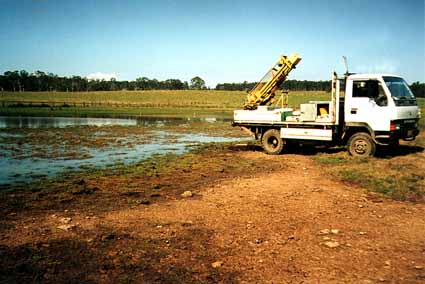A low lying site, often waterlogged, a hydrosol.
The features of Hydrosols on Tocal are:
- formed in low-lying situations subject to permanent or seasonal waterlogging
- poor site and internal drainage indicated by rusty mottling in subsoil
- high organic matter content
- heavy clay soils, hard to cultivate.
Hydrosols are soils infuenced by seasonal or permanently wet conditions for at least 2-3 months in most years. Livestock are excluded from particularly sensitive areas.
Under saturated conditions organic matter doesn't break down easily and this profile has a high organic matter content right down the profile.
This soil has high levels of soluble salts right down the profile showing that salts are probably present in the groundwater and surface water. These salts originate from the weathering of rocks and soils in the catchment. They are leached downslope and accumulate in the deep clay subsoils of the valley floors. They are brought to the surface when the water table is raised by clearing deep-rooted native vegetation or as the wetland soil dries out.

Profile description
- 0cm: A horizon.Very dark grey-brown light clay. Traces of burnt soil in the top section. Soft surface. Good structure. Plant roots very common. Fair drainage. pH 5.2
- 20cm: B horizon.Dark grey-brown medium clay. Very weak rusty mottles. PLant roots very common. Fair drainage. Good structure. Traces of burnt soil at 45 cm. pH 5.9
- 75cm: C horizon.Dark greyish brown silty clay. Rusty mottles along root channels (ferihydrite). Roots common although poor drainage. pH 5.9
Tocal newsletter
Want to find out about news, events, courses and publications?

